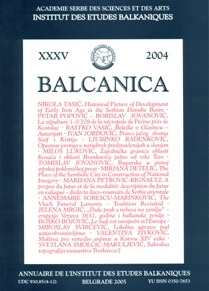Sakralna topografija manastira Treskavca
The Sacral Topography of the Monastery of Treskavac
Author(s): Svetlana Smolčić-MakuljevićSubject(s): Fine Arts / Performing Arts, Eastern Orthodoxy
Published by: Balkanološki institut - Srpska akademija nauka i umetnosti
Keywords: monastery’s topography; Mt Treskavac; sacral topography;
Summary/Abstract: The streches of Mt Treskavac with Zlatovrh, a dominant peak in Pelagonija, and its distinctive rocky landscape have o.ered a suitable setting for exercising austere monastic practices ever since medieval times. The sacred area formed around the Monastery of the Dormition of the Virgin in medieval times was founded on the antique sacred place of Kolobaise and the temples of Artemis of Ephesus and Apollo Euthanatos. To medieval renovation of the monastery besides the Byzantine and Bulgarian rulers, also contributed the Serbian rulers of the Nemanjić house, kings Milutin, Stefan of Dečani and Dušan. Testimonies to a stay at Treskavac were left by the Serbian nobles – enochiar Dabiživ and tepčija Gradislav. The cult of the Virgin of Treskavac, con.rmed in the written sources beginning with king Dušan’s charters to the monastery (1334–1343), left its trace both in the wall-painting of the monastery church and in the activity of manuscript copying cultivated in this monastic centre. Over the centuries, many pilgrims, from the royalty, local lords and members of well-to-do families to priests and monks, Orthodox Christians but also non-Christians, came to show their respect to the Virgin of Treskavac. A small cave church has been recently registered in the immediate vicinity of the monastery. An evidence of the eremitic way of life, it con.rms the information contained in king Dušan’s charters. Namely, they compare the way of life of the monks of Treskavac with the ascetic practice of Mount Athos and Mount Sinai. The area of Mt Treskavac also shows several rock paintings with a cultic function. This authentic manner of marking out a sacred area may be explained by the prophylactic role of the Virgin, or a Christian saint, in a barely passable, perilous landscape. Springs and drinking fountains constitute another important element of the monastery’s topography. Through the monks’ continuous and devout e.ort put into shaping the landscape, the fresh and icy cold water from the mountain springs has been captured and channelled into drinking fountains for the use both of the dwellers of the monastery and of pilgrims.
Journal: BALCANICA
- Issue Year: 2004
- Issue No: 35
- Page Range: 285-322
- Page Count: 38
- Language: Serbian

